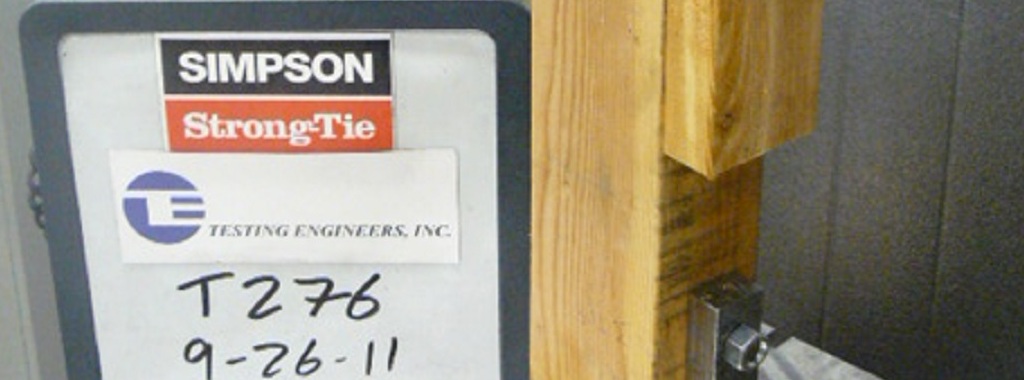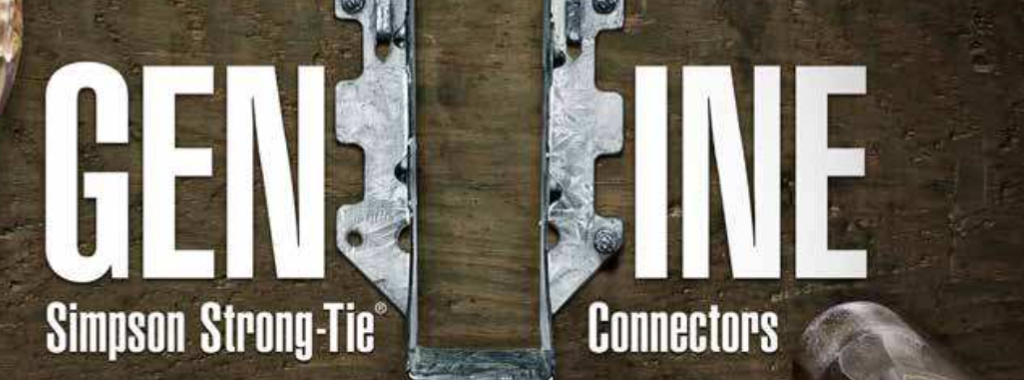On the About Paul McEntee page of this blog, I told the story about hosting Take Our Daughters and Sons to Work Day, which was four years ago. My son Ryan then described my job as, “Goes and gets coffee and sits at his desk.” I don’t know what my daughter Kira would have said about my job, as she was too young to attend back then, but ever since I took her brothers she has been asking, “Daddy, when do the kids get to go to your work again?” So, of course, we just had to have this event again this year on April 30.Continue Reading
Category: In the Coffer
Not everything fits into an easy category. “In the Coffer” is where our engineers cut loose and talk about personal passions.
Why Won't The Wood Fit?
Your wood fastening products seem to be built for yesteryear wood sizes. 2x’s are no longer larger than 1½”. Why can’t you manufacture these products with a little closer tolerance?
I received this question from a customer a few days ago via Ask Simpson, a web page where you can submit technical questions to our Engineering Department and we respond by e-mail. We have received similar variations of this question countless times over the years, so I thought it could use some discussion.
The National Design Specification for Wood Construction (NDS) Supplement Table 1A “Nominal and Minimum Dressed Sizes of Sawn Lumber” gives the minimum dry and green dimensions for sawn lumber. This specifies a nominal 2x, for example, as being 1½” dry and 1 9/16” green. NDS Supplement Section 3.1.1 defines dry lumber being seasoned to a moisture content of 19% or less, whereas green lumber is higher than 19%.
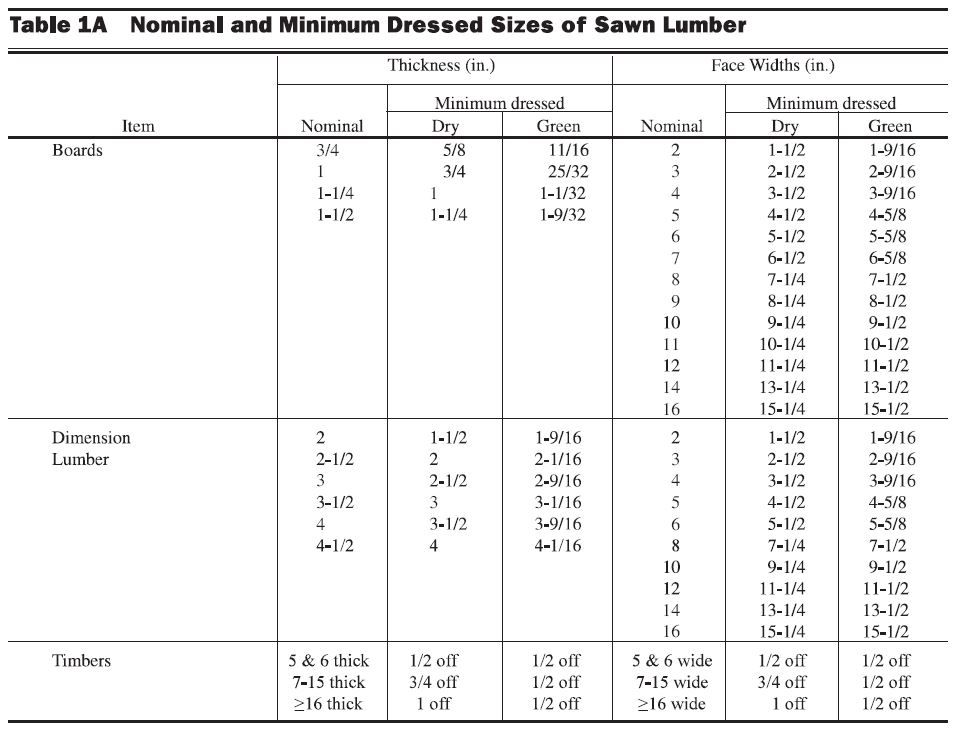
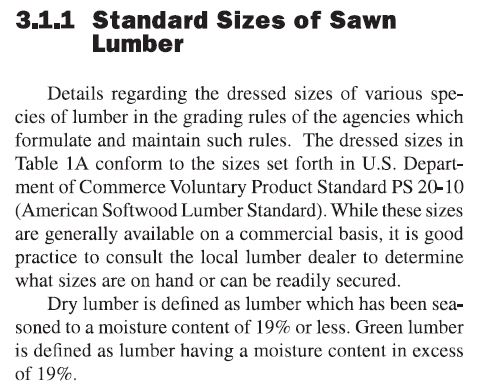
So what size do you make the connector?
Continue Reading
Why Won’t The Wood Fit? Understanding Lumber Size
Lumber size is often given in “nominal” measurements. This can often lead to confusion when someone is shopping for wood and wood connectors. Paul McEntee, Simpson Strong-Tie Manager of Engineering R&D, addressed lumber sizes and how our company takes them into consideration during product development and testing.
The Omega Factor
Section 12.4.3.3 of ASCE 7-05 (or -10) deals with overstrength (Ωo) load combinations and allows a 1.2 increase in allowable stress when using these combinations. We received a question from a customer last week asking if the 20% increase applies to Simpson Strong-Tie connectors. The simple answer is yes. When demand loads are based on amplified seismic forces, connector allowable loads may be increased by 1.2 per Section 12.4.3.3.
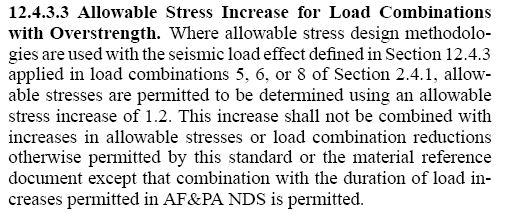
Since the increase may be combined with the duration of load increases permitted in the NDS, you would apply the 1.2 increase to connector allowable loads at a load duration of 1.6, which makes the overstrength factor a little less terrible.
The question got me thinking a little more about overstrength load combinations, so I wanted to discuss what they are used for. It also made me think about a sales meeting several years ago where one of our engineers was addressing a question about an application that required a design using amplified seismic forces. A salesperson asked why the forces needed to be amplified and he said, “Well, there’s this Omega subzero factor…” Never speak in Greek letters to salespeople. They call him Omega Subzero to this day.
So why does the code have amplified forces?
Structural Engineering Blog: One-Year Anniversary

This month marks the one-year anniversary of the Simpson Strong-Tie® Structural Engineering Blog! To celebrate, we are holding a contest for our blog readers and sharing a few interesting statistics about the blog, along with our Top 5 Blog Posts from April 2012 to today.
Everyone who posts a comment or subscribes to receive email notifications to the blog (new subscribers only) from now until April 30, 2013 will be entered to win one of five Prize Packs. The Prize Pack consists of:
- The opportunity to provide the subject for a future blog post
- A Simpson Strong-Tie thermal travel mug
- Your choice between a $25 Starbucks gift card OR a hard cover copy of: “Engineers: From the Great Pyramids To the Pioneers of Space Travel”, by DK Publishing
The contest is open to U.S. and Canadian residents (except Quebec) only. One entry per person. Five entries will be randomly selected to receive a Prize Pack. You can read the Official Rules here.
Is Designing with Wood Easy?
In college, I spent some of my free time either attending seminars or reading about high profile structural engineering projects. These projects tend to be noteworthy due to their massive scale or their use of innovative construction technologies (often both). Taipei 101 is 508 meters tall, and used to be the tallest building in the world. The Burj Khalifa has surpassed it as not only the tallest building in the world, but as the tallest manmade structure at 828 meters.
I never thought I would design the world’s tallest buildings, but I did think it would be cool to work on some mid-rises. I never did. My design firm didn’t do that type of work – which looking back, was a good thing for me. We worked on a lot of everything, including commercial, industrial, multi-family and mixed-used projects. The variety of projects meant designing with all the major building materials, including concrete, steel, masonry, and wood. Reviewing my project portfolio and thinking about what was really satisfying to work on, the projects that stand out most were wood-framed.
2012 Autodesk University
Autodesk University is an annual conference focused on keeping the design community up to date on the latest innovations, trends and technologies in design, drafting and visualization. Last year, Autodesk University was held in Las Vegas the week after Thanksgiving. Sadly, events always seem to conspire to prevent me from going to Vegas, but Simpson Strong-Tie was well represented by Frank Ding, our Engineering Analysis & Technical Computing Manager.
It was an exciting time attending my first Autodesk University in 2012. I have been to so many technical conferences during my professional career, but this one was quite different in scale, and the sheer size of it just blew me away. There were more than 8,000 attendees from 102 countries, more than 750 classes offered, and 163 exhibitors. I was impressed by the organization of such a large event, along with the online and mobile apps provided to help attendees manage their conference schedules.Continue Reading
So, What’s Behind A Screw’s Allowable Load?
This is Part 2 of a four-part series I’ll be doing on how connectors, fasteners, anchors and cold-formed steel systems are load rated. Read Part 1 and Part 1A.
These loads just can’t be right! Occasionally, I get this statement from engineers. This happens when they have been specifying commodity fasteners based on NDS load values and they get their first look at our higher screw values. Then the call comes in. They want to talk to someone to confirm what they are seeing is correct. I assure them the loads are right and give them this brief overview of how we got here:
Our first structural screw, the Simpson Strong-Tie(R) Strong-Drive(R) SDS, was originally load rated by plugging the bending yield strength and diameter into the NDS yield limit equations and using the load value from the governing failure mode. As later editions of the NDS modified the calculations and we did more testing, we found that the tested ultimate load of the SDS screw could be as much as ten times greater than the allowable load generated from the NDS equations.
So, What's Behind A Screw's Allowable Load?
This is Part 2 of a four-part series I’ll be doing on how connectors, fasteners, anchors and cold-formed steel systems are load rated. Read Part 1 and Part 1A.
These loads just can’t be right! Occasionally, I get this statement from engineers. This happens when they have been specifying commodity fasteners based on NDS load values and they get their first look at our higher screw values. Then the call comes in. They want to talk to someone to confirm what they are seeing is correct. I assure them the loads are right and give them this brief overview of how we got here:
Our first structural screw, the Simpson Strong-Tie(R) Strong-Drive(R) SDS, was originally load rated by plugging the bending yield strength and diameter into the NDS yield limit equations and using the load value from the governing failure mode. As later editions of the NDS modified the calculations and we did more testing, we found that the tested ultimate load of the SDS screw could be as much as ten times greater than the allowable load generated from the NDS equations.
Continue Reading
Tell Us Your Genuine Story for a Chance To Win!
You may have noticed that the cover of our new 2013-14 Wood Construction Connectors Catalog features the word GENUINE. What do we mean by Genuine Simpson Strong-Tie Connectors? It’s really based on our roots and our founder Barclay Simpson, who made his very first connector for a customer in 1956. Barc believed in doing whatever it took to help the customer succeed.Today, helping the customer remains our number one priority. Whether that’s being on a jobsite to help with a product installation, spending endless hours on R&D and product testing or making sure our products get to our customers on time. This is what we promise to do everyday, and we do it genuinely.Continue Reading




